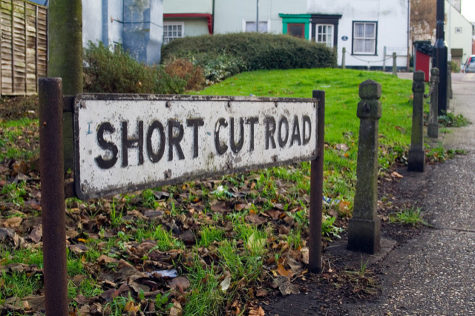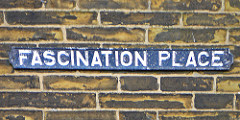 Let’s call the thoroughfare I live on Lemon Grove. There are two signs for it, one at each end of our block. Until very recently, one of the signs read, “Lemon Grove Avenue”. The other said, “Lemon Grove Street”.
Let’s call the thoroughfare I live on Lemon Grove. There are two signs for it, one at each end of our block. Until very recently, one of the signs read, “Lemon Grove Avenue”. The other said, “Lemon Grove Street”.
When someone asks for my address, I usually don’t say either. I just say I live on Lemon Grove. Often, the person will say, “Is there another part of that? Is it a street or a drive or something?”
“I don’t know,” I say. “You can pick if you want.”
This made me start thinking about where our street names come from. The decision-makers change from place to place—often, a developer coins the name, but needs to get approval from local government. The Post Office also weighs in.
Different areas have different restrictions on determining the type of roadway, whether street or road or boulevard. In Santa Clara, California, rules from 1989 state that dead-end streets should be called “Place” or “Court”; streets that loop are to be dubbed “Circle”.
According to the curator of the National Postal Museum, streets were once simple paved channels to get from one place to the other in an urban area; avenues were wider, more impressive tree-lined arteries. She told Smithsonian that the lines between these two has become fuzzier, because of developers’ desire to impress potential buyers. The American Institute of Architects has also proposed some guidelines for classifying roads. An avenue is a short, medium-speed affair that ends up at at an important building or monument—the avenue is the extension of the square. A boulevard is wider still; a road is more rural.
The street gods haven’t seemed to be paying attention, at least not where I live. One of the boulevards a few blocks away has no sidewalks, is barely wide enough for two-way traffic, and dead-ends at the bluffs. One street that curves along the hillside is called a mall, in Spanish. And last month, the sign at one end of our tiny, quiet block was replaced with a new, matching one: Lemon Grove Avenue. I felt suddenly committed to a place that didn’t quite fit. The sense that I lived in this in-between space—a place where no one could quite remember enough to decide on a name.

I suppose there’s some security in having a more clear street name. Streets do give us a sense of who we are. According to a study last year in the Journal of Economic Geography, people in Scotland who lived in neighborhoods where street names had a British flavor—names like “Queen Street” or “Regent Street”—were less likely to say that they primarily identified as being Scottish. Those who lived near streets that with religiously-themed names were more likely to identify themselves as Christian.
There is a word for the names given to streets–odonyms. A few years ago, The Washington Post looked at the most popular odonyms around the country. Many streets were named for important historical figures, others for natural beauty: tree names, numbers, and presidential surnames were the most popular (perhaps, the Post posited, because these were least likely to be controversial.) Some states had unique number ones: Colorado’s was Aspen, its iconic tree; Hawaii’s top street name was Lehua, the flower of the big island.
Other streets whisk us off to places that we might wish we were instead. I once lived in a community that seemed to have been imported from the Alps, with ways named Schussing and Sitzmark. The neighborhood I lived in on the edge of Oakland got its street names from places in the English countryside—our neighborhood had its own beauty, but maybe the builder had longed for heather instead of chaparral. (I have also lived on some streets that were just plain weird—one had a name that technically meant “the flavorings,” but my friends in high school teased me about living on “stinky” street.)
I’ve also heard more cynical types say that developments and the streets within them get their names from the things they are destroying. Others say that developers name streets after their partners, kids, or mistresses. In one way or another, city street signs record a shared past, and can capture personal histories as well.
I think of my first street name and remember the gang of boys that let me run around with them, the carpool rides where we’d sit in the way back of the station wagon. When my husband and his siblings talk about their childhood, the name of his street runs frequently through his stories—both as a physical location and an epicenter of memories, a landmark of both time and place.
I hope that those who have the power of odonymy choose their new streets with care. They are the sort of words that end up being used so frequently we almost stop noticing them, but they still color our worlds in unexpected ways. For me, living on an avenue tied me in to someone else’s vision of our street. I think it’s a grand place, too, but that has nothing to do with the width of the asphalt. It’s something that a person with a pen somewhere can’t see—all the people inside the houses that line the narrow sidewalks.
But things are looking up. Just this morning, I was peering at the map on my phone as I started off on a long walk. There I was, a little blue dot, standing on the corner of Lemon Grove Street. I looked up at the sign that proclaimed I was on Lemon Grove Avenue. And then I set out, happy to be not quite on the map again.
*
Images by Flickr users Nic McPhee and Tim Green under Creative Commons license
Lexington KY has two of my favorite groupings of street names. One subdivision’s streets are all named for past KY Derby winners. Another older neighborhood has streets all named for people and places out of King Arthur – Camelot Court, Sir Galahad Drive, etc.
Great stuff, Cameron! Odonyms – I’ll add that to my new vocabulary list.
I did something eerily similar with toponyms (place-names) in Southern Appalachia for my comprehensive exam, and I’ve been looking for ways to expand it. Send me an email if you get the chance; I’d love to talk more about it with you! Thanks, Cameron!!
Oh, Robin, those are great! I love fun pockets of interesting street names!
Thanks, Alex Anne!
I live in Indiananapolis on Talbott Street, which hosts the annual Talbot Street Art Fair. When the fair started in 1956, both spellings could be found on street signs. Someone eventually corrected the street signs to match the name of the woman the street was named for (Elizabeth Tinker Talbott), but the fair preserves the other spelling! A cross street close by used to be called Tinker Street, but became 16th St when the city decided to apply a numbered system. Several local establishments use Tinker Street in their names now, though, which is fun. (I love this stuff too…I grew up on Trombone Ct in a neighborhood with all music-related streets…Sibelius Dr, Mandolin Ct, Celeste Ct, etc….and another neighborhood nearby featured Shakespearean names like Falstaff Drive, Birnam Wood Drive, Titania Ct, and so on. )
Giedra, these are such lovely examples, you made my day! And how fun to grow up on Trombone Court!